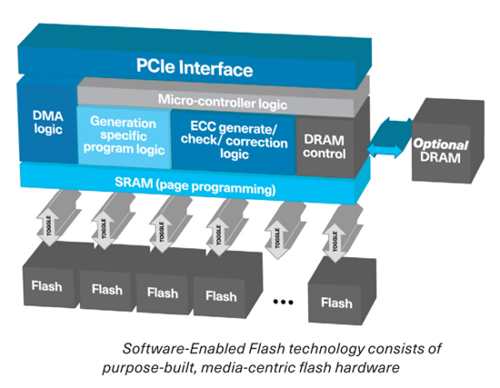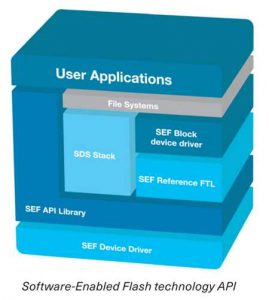SNIA SDC: Kioxia Showcased Software-Enabled Flash Technology
With demos of API and SDK that maximize value of flash memory
This is a Press Release edited by StorageNewsletter.com on October 5, 2021 at 2:03 pmAt SNIA‘s Storage Developer Conference (SDC), Kioxia Corp. has showcased its software-enabled flash technology.
At the virtual conference, the company has updated developers on advancements made to their technology, as well as introduce a software-enabled flash SDK that allows for faster time to market, easier development and abstractions. The firm, a longstanding SNIA member, has worked within the association to develop and enhance many technologies throughout the storage industry.
The company’s software-enabled flash technology helps hyperscale cloud providers and storage developers maximize the value of flash memory. By removing the impediment of legacy protocols used by current designs and architecting a completely new way of using flash, software-enabled flash technology delivers software-defined flash to hyperscale users. Software-enabled flash technology redefines the relationship between the host and flash devices, allowing cloud-scale users to unlock the most value from their flash. With this technology, developers are freed from narrowly defined ‘drive’ behavior, which presents challenges for applications requiring control over workload isolation, data placement, and QoS.
“We developed software-enabled flash technology to deliver the full value of flash memory and solve the unique problems of hyperscale cloud providers and storage developers,” said Eric Ries, SVP, memory storage strategy division (MSSD), Kioxia America, Inc. “The software-enabled flash SDK builds on the existing API and provides an even easier, more compelling way to use flash. Software-enabled flash technology is a force multiplier in data center economics, and we know it takes a community of developers and vendors to make a revolutionary project like this work. We look forward to engaging in discussions at SDC and bringing together flash vendors, controller manufacturers and end users to make this open standard successful.“
Collaborating with hyperscale developers, the company has made software-enabled flash technology more powerful and easier to use with a new, higher-level SDK. It enables low-code prototyping and evaluation by providing high-level abstractions to speed application development and flash deployment. It enhances the software-enabled flash ecosystem with a reference flash translation layer and virtual I/O device, as well as command-line management and testing utilities. It also preserves access to the low-level software-enabled flash API primitives: workload isolation, QoS management, latency outcome control, gen and vendor abstraction, and flash management offload.
Together, the software-enabled flash API and SDK help speed the move between different flash technologies such as from TLC to QLC, allowing the hyperscale cloud to adopt these new technologies faster and more efficiently.
SDC keynote session:
An SDC sponsor, Kioxia has been selected to present a keynote session at the conference. Titled Maximizing Flash Value with the Software-Enabled Flash SDK, the session was presented by Eric Ries and Rory Bolt, senior fellow, MSSD, Kioxia America, on September 28. It details how the software-enabled flash SDK from te company helps developers solve storage challenges and derive the maximum value of deployed flash – at hyperscale.
SDC ‘Birds of a Feather‘ discussion session
Kioxia America’s Earle Philhower and Sean Stead have lead a session titled Future Innovations in Software-Defined Flash Storage.Today’s data centers are almost fully software-defined, from the software-defined network to virtualized and containerized computation to the software-defined file system. This session took a closer look at one important part of the stack that’s not yet software-defined: flash storage itself. Enabling flash storage to be software-defined allows flash to be tailored to the specific needs of any application. This session was center on the software-defined flash capabilities that storage developers need, and will explain how software-defined flash APIs can affect how storage applications are written and run in the future. All SDC Birds of a Feather sessions were live events, and the Kioxia session on September 28.
The company’s video demonstrating the software-enabled flash SDK supporting multiple flash drive protocols, including Zoned Namespace, standard block, and customized flash translation layer modes.
Software-enabled flash hardware is compliant with PCIe and NVMe standards, enabling a large ecosystem and accelerating open innovation across multiple products. The API spec is available on the Kioxia America on GitHub site.














 Subscribe to our free daily newsletter
Subscribe to our free daily newsletter
